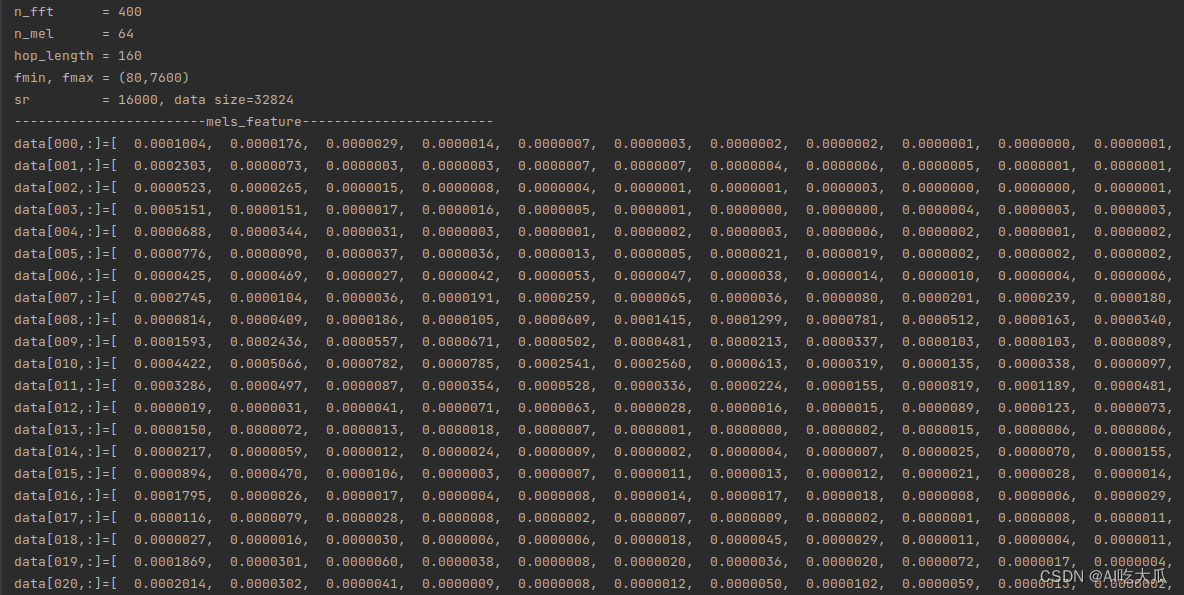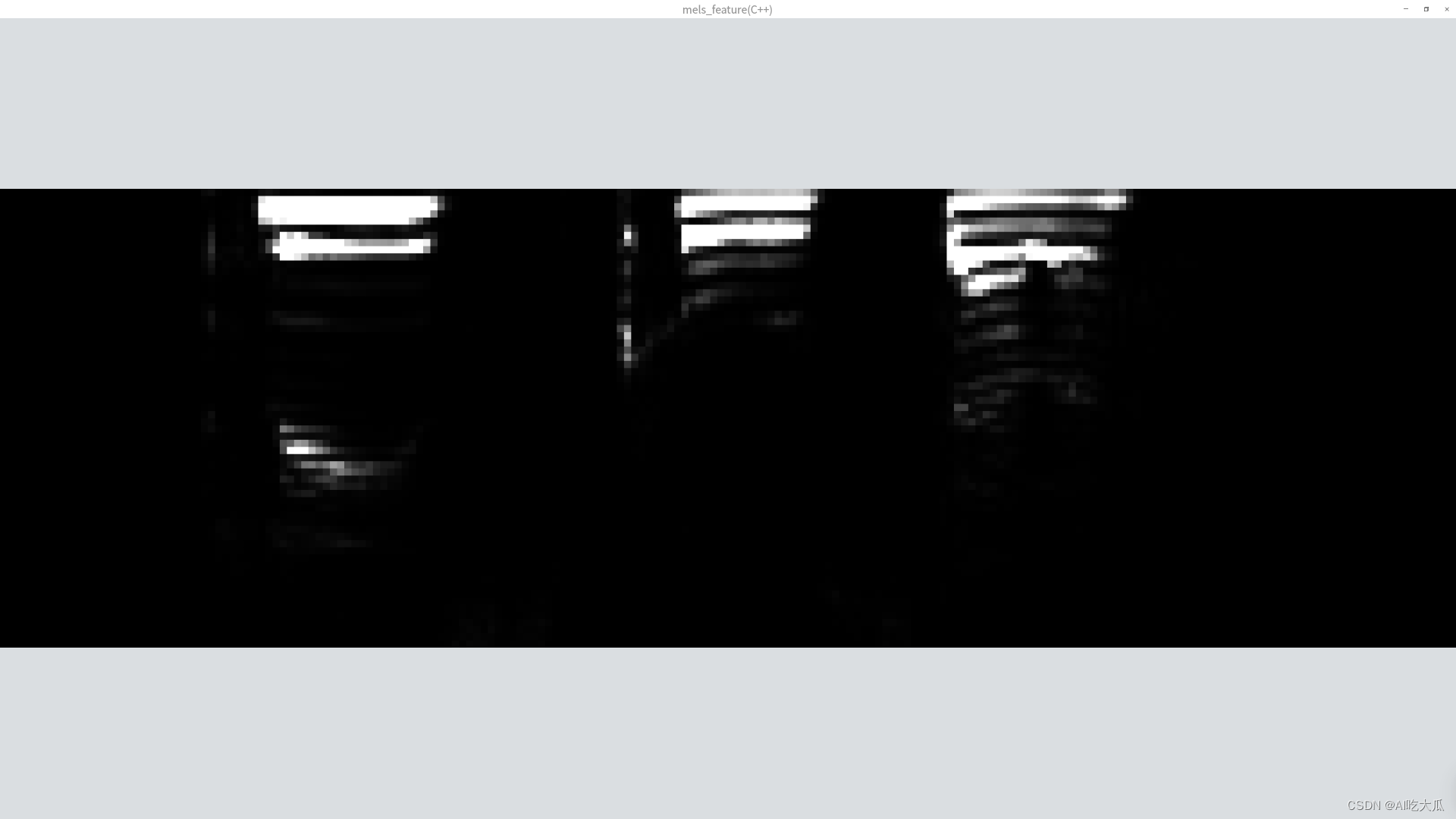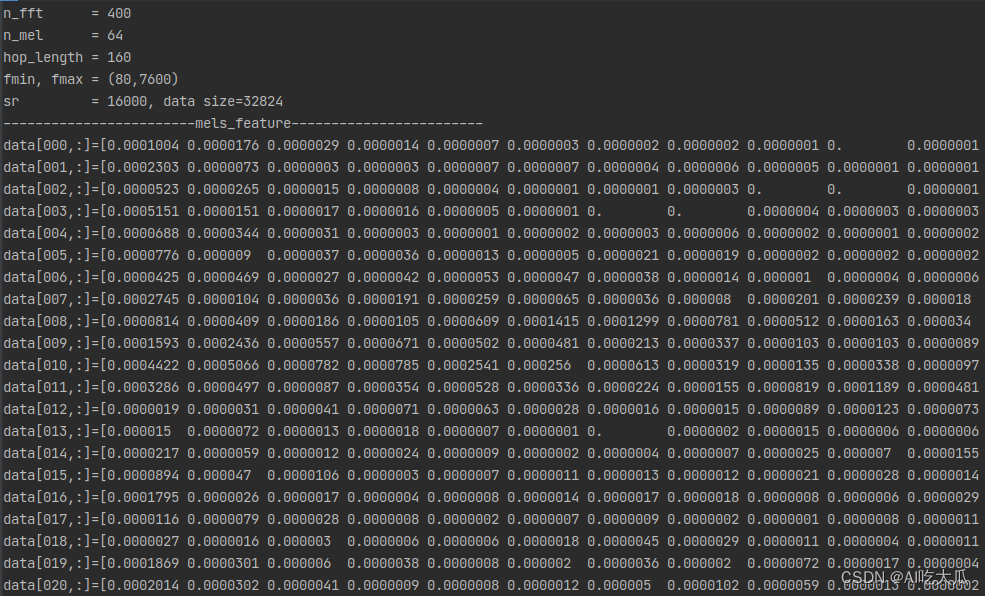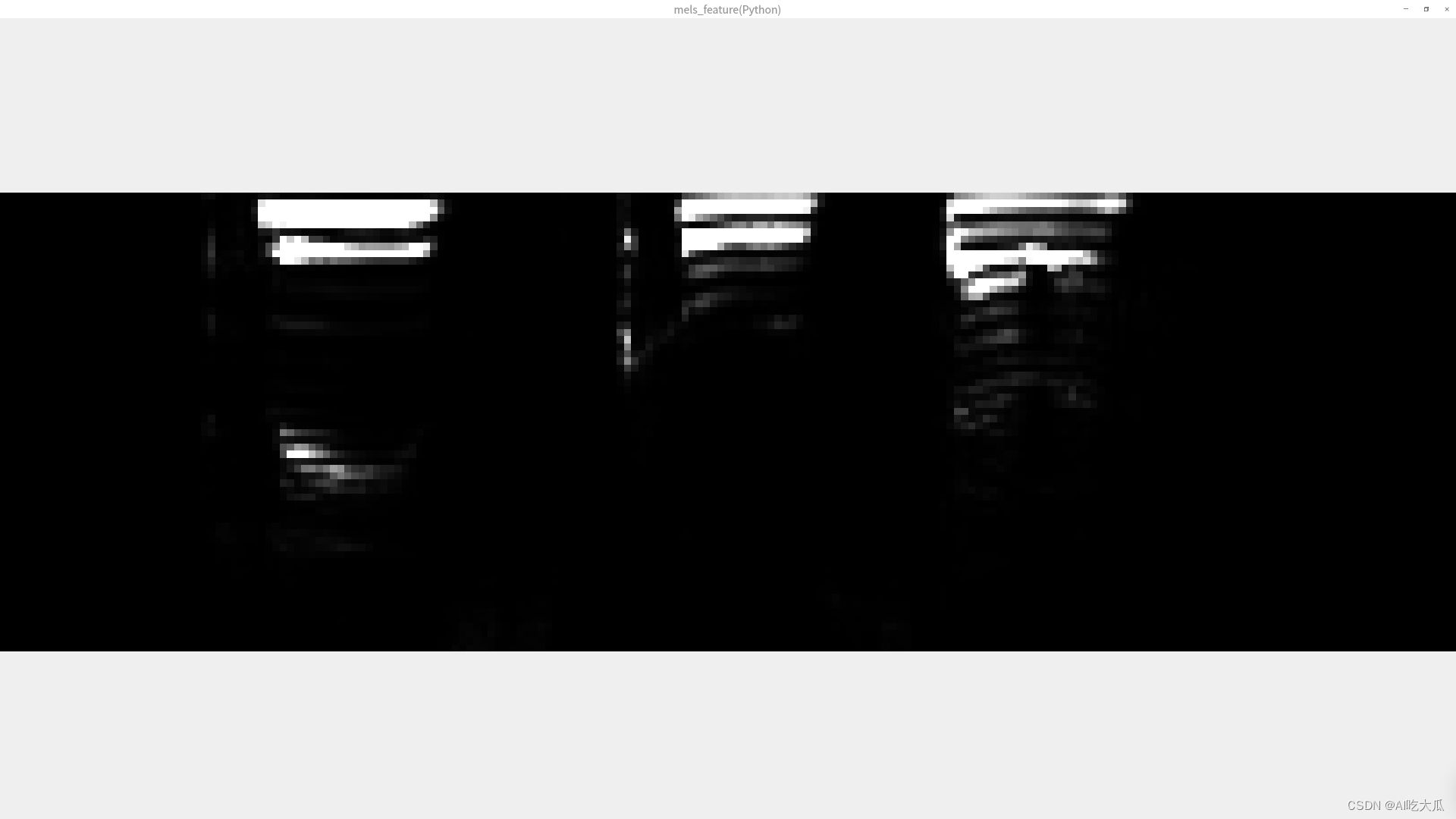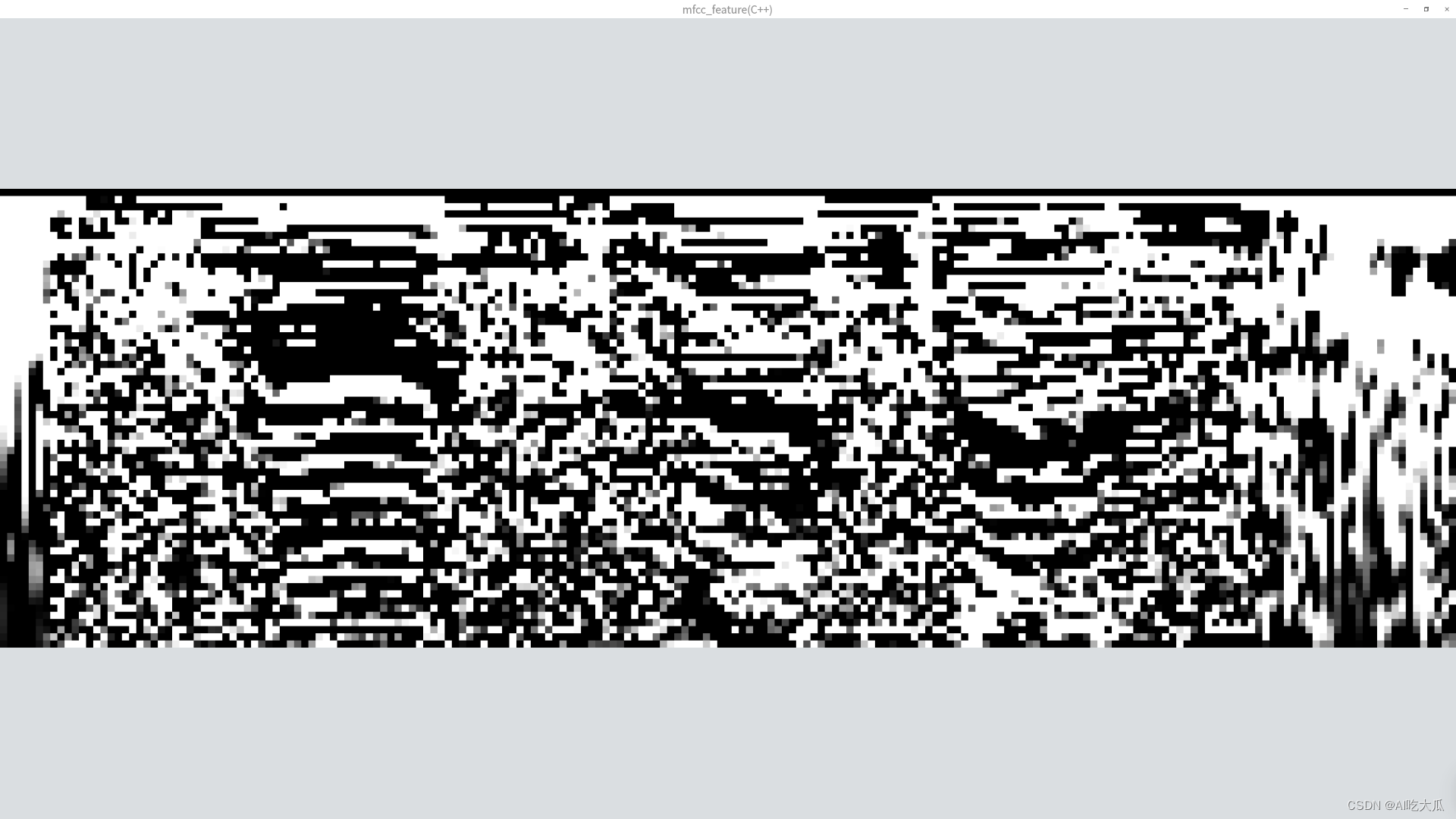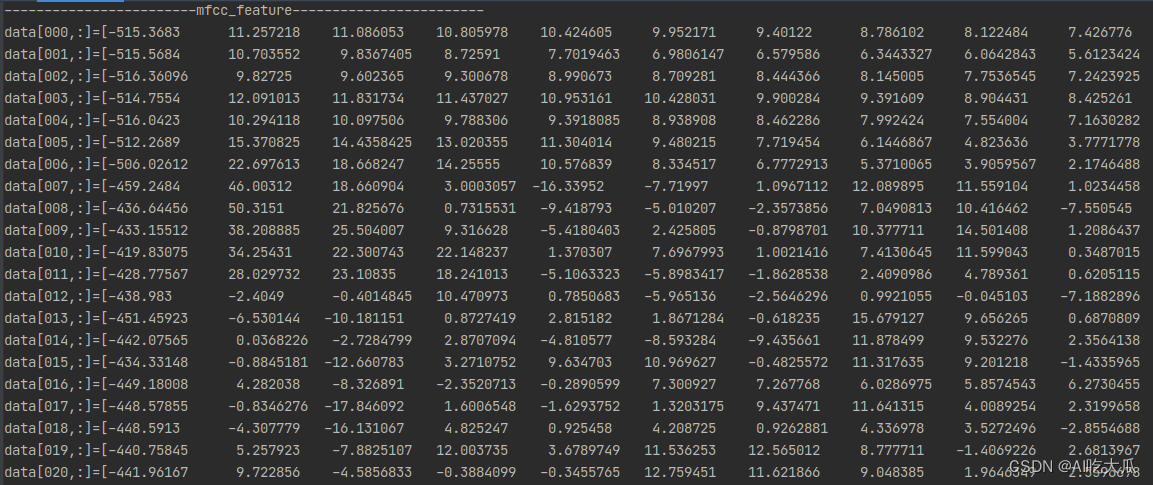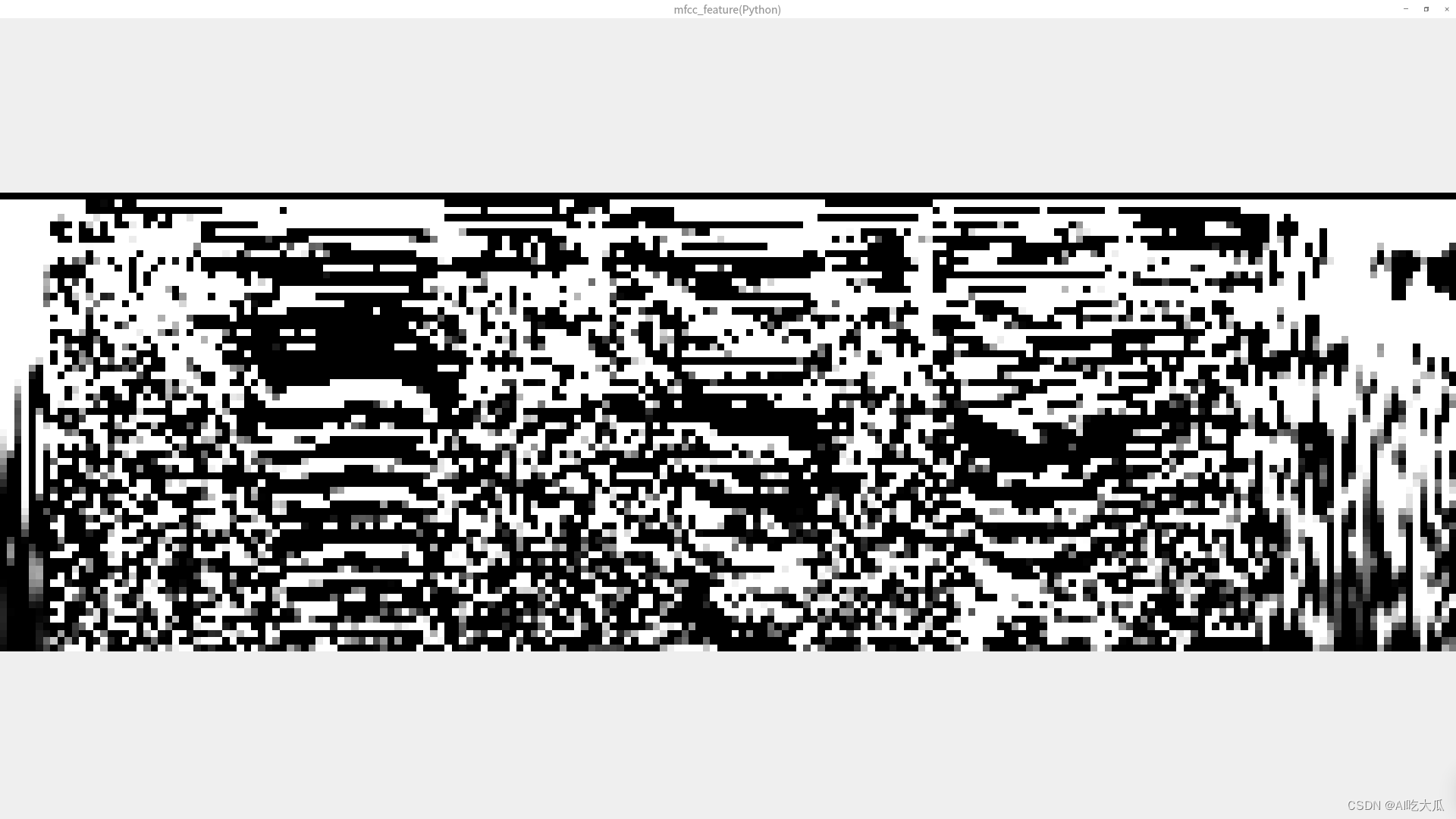C/C++实现librosa音频处理库melspectrogram和mfcc
目录
C/C++实现librosa音频处理库melspectrogram和mfcc
深度学习语音处理中,经常要用到音频处理库librosa,奈何librosa目前仅有python版本;而语音识别算法开发中,经常要用到melspectrogram(Mel-spectrogram梅尔语谱图)和MFCC(梅尔频率倒谱系数)这些音频信息,因此需要实现C/C++版本melspectrogram和MFCC;网上已经存在很多版本的C/C++的melspectrogram和MFCC,但测试发现跟Python的librosa的处理结果存在很大差异;经过多次优化测试,本项目实现了C/C++版本的音频处理库librosa中load、melspectrogram和mfcc的功能,项目基本完整对齐Pyhon音频处理库librosa三个功能:
- librosa.load:实现语音读取
- librosa.feature.melspectrogram:实现计算梅尔语谱图melspectrogram
- librosa.feature.mfcc:实现计算梅尔频率倒谱系数MFCC

【尊重原创,转载请注明出处】https://blog.csdn.net/guyuealian/article/details/132077896
1.项目结构
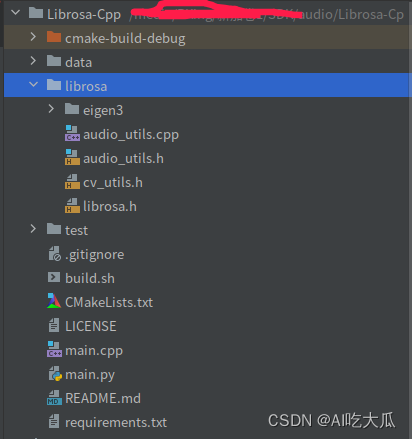
2.依赖环境
项目需要安装Python和C/C++相关的依赖包
Python依赖库,使用pip install即可
numpy==1.16.3
matplotlib==3.1.0
Pillow==6.0.0
easydict==1.9
opencv-contrib-python==4.5.2.52
opencv-python==4.5.1.48
pandas==1.1.5
PyYAML==5.3.1
scikit-image==0.17.2
scikit-learn==0.24.0
scipy==1.5.4
seaborn==0.11.2
tqdm==4.55.1
xmltodict==0.12.0
pybaseutils==0.7.6
librosa==0.8.1
pyaudio==0.2.11
pydub==0.23.1
C++依赖库,主要用到Eigen3和OpenCV
- Eigen3:用于矩阵计算,项目已经支持Eigen3,无须安装
- OpenCV: 用于显示图像,安装方法请参考Ubuntu18.04安装opencv和opencv_contrib
3.C++ librosa音频处理库实现
语音处理中常用的特征值: Mel频谱图(Mel Spectrogram)和Mel频率倒谱系数(Mel Frequency Cepstrum Coefficient, MFCC),参考文章:https://www.cnblogs.com/Ge-ronimo/p/17281385.html
(1) 对齐读取音频文件
Python中可使用librosa.load读取音频文件
data, sr = librosa.load(path, sr, mono)Python实现读取音频文件:
# -*-coding: utf-8 -*-
import numpy as np
import librosa
def read_audio(audio_file, sr=16000, mono=True):
"""
默认将多声道音频文件转换为单声道,并返回一维数组;
如果你需要处理多声道音频文件,可以使用 mono=False,参数来保留所有声道,并返回二维数组。
:param audio_file:
:param sr: sampling rate
:param mono: 设置为true是单通道,否则是双通道
:return:
"""
audio_data, sr = librosa.load(audio_file, sr=sr, mono=mono)
audio_data = audio_data.T.reshape(-1)
return audio_data, sr
def print_vector(name, data):
np.set_printoptions(precision=7, suppress=False)
print("------------------------%s------------------------\n" % name)
print("{}".format(data.tolist()))
if __name__ == '__main__':
sr = None
audio_file = "data/data_s1.wav"
data, sr = read_audio(audio_file, sr=sr, mono=False)
print("sr = %d, data size=%d" % (sr, len(data)))
print_vector("audio data", data)
C/C++读取音频文件:需要根据音频的数据格式进行解码,参考:C语言解析wav文件格式 ,本项目已经实现C/C++版本的读取音频数据,可支持单声道和双声道音频数据(mono)
/**
* 读取音频文件,目前仅支持wav格式文件
* @param filename wav格式文件
* @param out 输出音频数据
* @param sr 输出音频采样率
* @param mono 设置为true是单通道,否则是双通道
* @return
*/
int read_audio(const char *filename, vector<float> &out, int *sr, bool mono = true);#include <iostream>
#include <vector>
#include <algorithm>
#include "librosa/audio_utils.h"
#include "librosa/librosa.h"
using namespace std;
int main() {
int sr = -1;
string audio_file = "../data/data_s1.wav";
vector<float> data;
int res = read_audio(audio_file.c_str(), data, &sr, false);
if (res < 0) {
printf("read wav file error: %s\n", audio_file.c_str());
return -1;
}
printf("sr = %d, data size=%d\n", sr, data.size());
print_vector("audio data", data);
return 0;
}
测试和对比Python和C++版本读取音频文件数据,经过多轮测试,二者的读取的音频数值差异已经很小,基本已经对齐python librosa库的librosa.load()函数
| 数值对比 | |
| C++版本 | 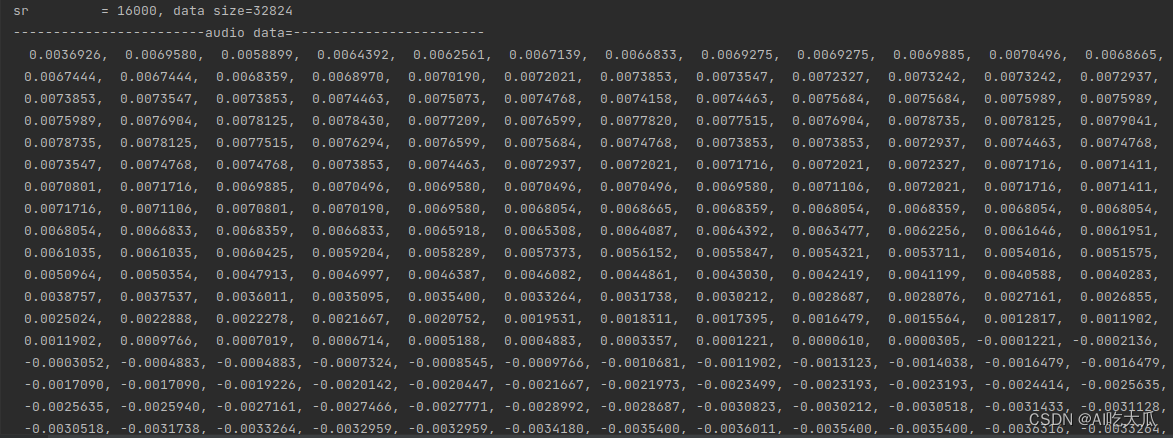 |
| Python版本 | 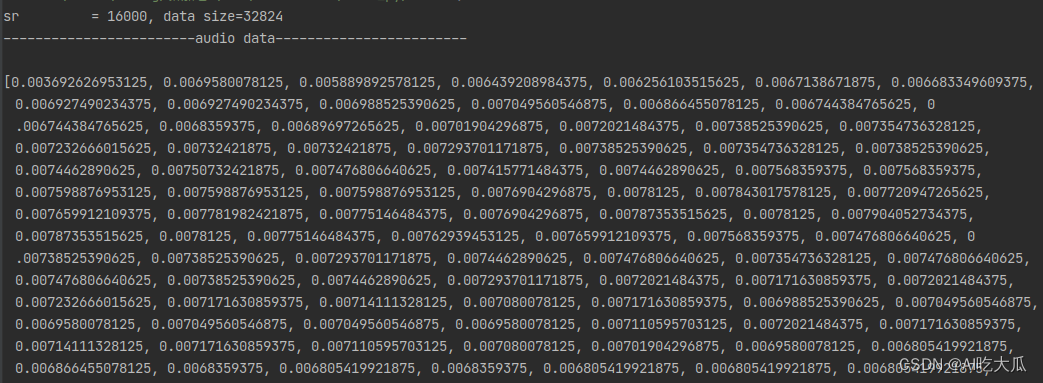 |
(2) 对齐Mel频谱图melspectrogram
关于melspectrogram梅尔频谱的相关原理,请参考基于梅尔频谱的音频信号分类识别(Pytorch)
Python的librosa库的提供了librosa.feature.melspectrogram()函数,返回一个二维数组,可以使用OpenCV显示该图像
def librosa_feature_melspectrogram(y,
sr=16000,
n_mels=128,
n_fft=2048,
hop_length=256,
win_length=None,
window="hann",
center=True,
pad_mode="reflect",
power=2.0,
fmin=0.0,
fmax=None,
**kwargs):
"""
计算音频梅尔频谱图(Mel Spectrogram)
:param y: 音频时间序列
:param sr: 采样率
:param n_mels: number of Mel bands to generate产生的梅尔带数
:param n_fft: length of the FFT window FFT窗口的长度
:param hop_length: number of samples between successive frames 帧移(相邻窗之间的距离)
:param win_length: 窗口的长度为win_length,默认win_length = n_fft
:param window:
:param center: 如果为True,则填充信号y,以使帧 t以y [t * hop_length]为中心。
如果为False,则帧t从y [t * hop_length]开始
:param pad_mode:
:param power: 幅度谱的指数。例如1代表能量,2代表功率,等等
:param fmin: 最低频率(Hz)
:param fmax: 最高频率(以Hz为单位),如果为None,则使用fmax = sr / 2.0
:param kwargs:
:return: 返回Mel频谱shape=(n_mels,n_frames),n_mels是Mel频率的维度(频域),n_frames为时间帧长度(时域)
"""
mel = librosa.feature.melspectrogram(y=y,
sr=sr,
S=None,
n_mels=n_mels,
n_fft=n_fft,
hop_length=hop_length,
win_length=win_length,
window=window,
center=center,
pad_mode=pad_mode,
power=power,
fmin=fmin,
fmax=fmax,
**kwargs)
return mel
根据Python版本的librosa.feature.melspectrogram(),项目实现了C++版本melspectrogram
/***
* compute mel spectrogram similar with librosa.feature.melspectrogram
* @param x input audio signal
* @param sr sample rate of 'x'
* @param n_fft length of the FFT size
* @param n_hop number of samples between successive frames
* @param win window function. currently only supports 'hann'
* @param center same as librosa
* @param mode pad mode. support "reflect","symmetric","edge"
* @param power exponent for the magnitude melspectrogram
* @param n_mels number of mel bands
* @param fmin lowest frequency (in Hz)
* @param fmax highest frequency (in Hz)
* @return mel spectrogram matrix
*/
static std::vector <std::vector<float>> melspectrogram(std::vector<float> &x, int sr,
int n_fft, int n_hop, const std::string &win, bool center,
const std::string &mode,
float power, int n_mels, int fmin, int fmax)测试和对比Python和C++版本melspectrogram,二者的返回数值差异已经很小,其可视化的梅尔频谱图基本一致。
| 版本 | 数值对比 |
| C++版本 |
|
| Python版本 |
|
(3) 对齐梅尔频率倒谱系数MFCC
Python版可使用librosa库的librosa.feature.mfcc实现MFCC(Mel-frequency cepstral coefficients)
def librosa_feature_mfcc(y,
sr=16000,
n_mfcc=128,
n_mels=128,
n_fft=2048,
hop_length=256,
win_length=None,
window="hann",
center=True,
pad_mode="reflect",
power=2.0,
fmin=0.0,
fmax=None,
dct_type=2,
**kwargs):
"""
计算音频MFCC
:param y: 音频时间序列
:param sr: 采样率
:param n_mfcc: number of MFCCs to return
:param n_mels: number of Mel bands to generate产生的梅尔带数
:param n_fft: length of the FFT window FFT窗口的长度
:param hop_length: number of samples between successive frames 帧移(相邻窗之间的距离)
:param win_length: 窗口的长度为win_length,默认win_length = n_fft
:param window:
:param center: 如果为True,则填充信号y,以使帧 t以y [t * hop_length]为中心。
如果为False,则帧t从y [t * hop_length]开始
:param pad_mode:
:param power: 幅度谱的指数。例如1代表能量,2代表功率,等等
:param fmin: 最低频率(Hz)
:param fmax: 最高频率(以Hz为单位),如果为None,则使用fmax = sr / 2.0
:param kwargs:
:return: 返回MFCC shape=(n_mfcc,n_frames)
"""
# MFCC 梅尔频率倒谱系数
mfcc = librosa.feature.mfcc(y=y,
sr=sr,
S=None,
n_mfcc=n_mfcc,
n_mels=n_mels,
n_fft=n_fft,
hop_length=hop_length,
win_length=win_length,
window=window,
center=center,
pad_mode=pad_mode,
power=power,
fmin=fmin,
fmax=fmax,
dct_type=dct_type,
**kwargs)
return mfcc
根据Python版本的librosa.feature.mfcc(),项目实现了C++版本MFCC
/***
* compute mfcc similar with librosa.feature.mfcc
* @param x input audio signal
* @param sr sample rate of 'x'
* @param n_fft length of the FFT size
* @param n_hop number of samples between successive frames
* @param win window function. currently only supports 'hann'
* @param center same as librosa
* @param mode pad mode. support "reflect","symmetric","edge"
* @param power exponent for the magnitude melspectrogram
* @param n_mels number of mel bands
* @param fmin lowest frequency (in Hz)
* @param fmax highest frequency (in Hz)
* @param n_mfcc number of mfccs
* @param norm ortho-normal dct basis
* @param type dct type. currently only supports 'type-II'
* @return mfcc matrix
*/
static std::vector<std::vector<float>> mfcc(std::vector<float> &x, int sr,
int n_fft, int n_hop, const std::string &win, bool center, const std::string &mode,
float power, int n_mels, int fmin, int fmax,
int n_mfcc, bool norm, int type)测试和对比Python和C++版本MFCC,二者的返回数值差异已经很小,其可视化的MFCC图基本一致。
| 版本 | 数值对比 |
| C++版本 |
|
| Python版本 |
|
4.Demo运行
- C++版本,可在项目根目录,终端输入:bash build.sh ,即可运行测试demo
#!/usr/bin/env bash
if [ ! -d "build/" ];then
mkdir "build"
else
echo "exist build"
fi
cd build
cmake ..
make -j4
sleep 1
./main
main函数
/****
* @Author : [email protected]
* @E-mail :
* @Date :
* @Brief : C/C++实现Melspectrogram和MFCC
*/
#include <iostream>
#include <vector>
#include <algorithm>
#include "librosa/audio_utils.h"
#include "librosa/librosa.h"
#include "librosa/cv_utils.h"
using namespace std;
int main() {
int sr = -1;
int n_fft = 400;
int hop_length = 160;
int n_mel = 64;
int fmin = 80;
int fmax = 7600;
int n_mfcc = 64;
int dct_type = 2;
float power = 2.f;
bool center = false;
bool norm = true;
string window = "hann";
string pad_mode = "reflect";
//string audio_file = "../data/data_d2.wav";
string audio_file = "../data/data_s1.wav";
vector<float> data;
int res = read_audio(audio_file.c_str(), data, &sr, false);
if (res < 0) {
printf("read wav file error: %s\n", audio_file.c_str());
return -1;
}
printf("n_fft = %d\n", n_fft);
printf("n_mel = %d\n", n_mel);
printf("hop_length = %d\n", hop_length);
printf("fmin, fmax = (%d,%d)\n", fmin, fmax);
printf("sr = %d, data size=%d\n", sr, data.size());
//print_vector("audio data", data);
// compute mel Melspectrogram
vector<vector<float>> mels_feature = librosa::Feature::melspectrogram(data, sr, n_fft, hop_length, window,
center, pad_mode, power, n_mel, fmin, fmax);
int mels_w = (int) mels_feature.size();
int mels_h = (int) mels_feature[0].size();
cv::Mat mels_image = vector2mat<float>(get_vector(mels_feature), 1, mels_h);
print_feature("mels_feature", mels_feature);
printf("mels_feature size(n_frames,n_mels)=(%d,%d)\n", mels_w, mels_h);
image_show("mels_feature(C++)", mels_image, 10);
// compute MFCC
vector<vector<float>> mfcc_feature = librosa::Feature::mfcc(data, sr, n_fft, hop_length, window, center, pad_mode,
power, n_mel, fmin, fmax, n_mfcc, norm, dct_type);
int mfcc_w = (int) mfcc_feature.size();
int mfcc_h = (int) mfcc_feature[0].size();
cv::Mat mfcc_image = vector2mat<float>(get_vector(mfcc_feature), 1, mfcc_h);
print_feature("mfcc_feature", mfcc_feature);
printf("mfcc_feature size(n_frames,n_mfcc)=(%d,%d)\n", mfcc_w, mfcc_h);
image_show("mfcc_feature(C++)", mfcc_image, 10);
cv::waitKey(0);
printf("finish...");
return 0;
}
- Python版本,可在项目根目录,终端输入:python main.py ,即可运行测试demo
# -*-coding: utf-8 -*-
"""
@Author :
@E-mail :
@Date : 2023-08-01 22:27:56
@Brief :
"""
import cv2
import numpy as np
import librosa
def cv_show_image(title, image, use_rgb=False, delay=0):
"""
调用OpenCV显示图片
:param title: 图像标题
:param image: 输入是否是RGB图像
:param use_rgb: True:输入image是RGB的图像, False:返输入image是BGR格式的图像
:param delay: delay=0表示暂停,delay>0表示延时delay毫米
:return:
"""
img = image.copy()
if img.shape[-1] == 3 and use_rgb:
img = cv2.cvtColor(img, cv2.COLOR_RGB2BGR) # 将BGR转为RGB
# cv2.namedWindow(title, flags=cv2.WINDOW_AUTOSIZE)
cv2.namedWindow(title, flags=cv2.WINDOW_NORMAL)
cv2.imshow(title, img)
cv2.waitKey(delay)
return img
def librosa_feature_melspectrogram(y,
sr=16000,
n_mels=128,
n_fft=2048,
hop_length=256,
win_length=None,
window="hann",
center=True,
pad_mode="reflect",
power=2.0,
fmin=0.0,
fmax=None,
**kwargs):
"""
计算音频梅尔频谱图(Mel Spectrogram)
:param y: 音频时间序列
:param sr: 采样率
:param n_mels: number of Mel bands to generate产生的梅尔带数
:param n_fft: length of the FFT window FFT窗口的长度
:param hop_length: number of samples between successive frames 帧移(相邻窗之间的距离)
:param win_length: 窗口的长度为win_length,默认win_length = n_fft
:param window:
:param center: 如果为True,则填充信号y,以使帧 t以y [t * hop_length]为中心。
如果为False,则帧t从y [t * hop_length]开始
:param pad_mode:
:param power: 幅度谱的指数。例如1代表能量,2代表功率,等等
:param fmin: 最低频率(Hz)
:param fmax: 最高频率(以Hz为单位),如果为None,则使用fmax = sr / 2.0
:param kwargs:
:return: 返回Mel频谱shape=(n_mels,n_frames),n_mels是Mel频率的维度(频域),n_frames为时间帧长度(时域)
"""
mel = librosa.feature.melspectrogram(y=y,
sr=sr,
S=None,
n_mels=n_mels,
n_fft=n_fft,
hop_length=hop_length,
win_length=win_length,
window=window,
center=center,
pad_mode=pad_mode,
power=power,
fmin=fmin,
fmax=fmax,
**kwargs)
return mel
def librosa_feature_mfcc(y,
sr=16000,
n_mfcc=128,
n_mels=128,
n_fft=2048,
hop_length=256,
win_length=None,
window="hann",
center=True,
pad_mode="reflect",
power=2.0,
fmin=0.0,
fmax=None,
dct_type=2,
**kwargs):
"""
计算音频MFCC
:param y: 音频时间序列
:param sr: 采样率
:param n_mfcc: number of MFCCs to return
:param n_mels: number of Mel bands to generate产生的梅尔带数
:param n_fft: length of the FFT window FFT窗口的长度
:param hop_length: number of samples between successive frames 帧移(相邻窗之间的距离)
:param win_length: 窗口的长度为win_length,默认win_length = n_fft
:param window:
:param center: 如果为True,则填充信号y,以使帧 t以y [t * hop_length]为中心。
如果为False,则帧t从y [t * hop_length]开始
:param pad_mode:
:param power: 幅度谱的指数。例如1代表能量,2代表功率,等等
:param fmin: 最低频率(Hz)
:param fmax: 最高频率(以Hz为单位),如果为None,则使用fmax = sr / 2.0
:param kwargs:
:return: 返回MFCC shape=(n_mfcc,n_frames)
"""
# MFCC 梅尔频率倒谱系数
mfcc = librosa.feature.mfcc(y=y,
sr=sr,
S=None,
n_mfcc=n_mfcc,
n_mels=n_mels,
n_fft=n_fft,
hop_length=hop_length,
win_length=win_length,
window=window,
center=center,
pad_mode=pad_mode,
power=power,
fmin=fmin,
fmax=fmax,
dct_type=dct_type,
**kwargs)
return mfcc
def read_audio(audio_file, sr=16000, mono=True):
"""
默认将多声道音频文件转换为单声道,并返回一维数组;
如果你需要处理多声道音频文件,可以使用 mono=False,参数来保留所有声道,并返回二维数组。
:param audio_file:
:param sr: sampling rate
:param mono: 设置为true是单通道,否则是双通道
:return:
"""
audio_data, sr = librosa.load(audio_file, sr=sr, mono=mono)
audio_data = audio_data.T.reshape(-1)
return audio_data, sr
def print_feature(name, feature):
h, w = feature.shape[:2]
np.set_printoptions(precision=7, suppress=True, linewidth=(11 + 3) * w)
print("------------------------{}------------------------".format(name))
for i in range(w):
v = feature[:, i].reshape(-1)
print("data[{:0=3d},:]={}".format(i, v))
def print_vector(name, data):
np.set_printoptions(precision=7, suppress=False)
print("------------------------%s------------------------\n" % name)
print("{}".format(data.tolist()))
if __name__ == '__main__':
sr = None
n_fft = 400
hop_length = 160
n_mel = 64
fmin = 80
fmax = 7600
n_mfcc = 64
dct_type = 2
power = 2.0
center = False
norm = True
window = "hann"
pad_mode = "reflect"
audio_file = "data/data_s1.wav"
data, sr = read_audio(audio_file, sr=sr, mono=False)
print("n_fft = %d" % n_fft)
print("n_mel = %d" % n_mel)
print("hop_length = %d" % hop_length)
print("fmin, fmax = (%d,%d)" % (fmin, fmax))
print("sr = %d, data size=%d" % (sr, len(data)))
# print_vector("audio data", data)
mels_feature = librosa_feature_melspectrogram(y=data,
sr=sr,
n_mels=n_mel,
n_fft=n_fft,
hop_length=hop_length,
win_length=None,
fmin=fmin,
fmax=fmax,
window=window,
center=center,
pad_mode=pad_mode,
power=power)
print_feature("mels_feature", mels_feature)
print("mels_feature size(n_frames,n_mels)=({},{})".format(mels_feature.shape[1], mels_feature.shape[0]))
cv_show_image("mels_feature(Python)", mels_feature, delay=10)
mfcc_feature = librosa_feature_mfcc(y=data,
sr=sr,
n_mfcc=n_mfcc,
n_mels=n_mel,
n_fft=n_fft,
hop_length=hop_length,
win_length=None,
fmin=fmin,
fmax=fmax,
window=window,
center=center,
pad_mode=pad_mode,
power=power,
dct_type=dct_type)
print_feature("mfcc_feature", mfcc_feature)
print("mfcc_feature size(n_frames,n_mfcc)=({},{})".format(mfcc_feature.shape[1], mfcc_feature.shape[0]))
cv_show_image("mfcc_feature(Python)", mfcc_feature, delay=10)
cv2.waitKey(0)
5.librosa库C++源码下载
C/C++实现librosa音频处理库melspectrogram和mfcc项目代码下载地址:C/C++实现librosa音频处理库melspectrogram和mfcc
项目源码内容包含:
- 提供C++版的read_audio()函数读取音频文件,目前仅支持wav格式文件,支持单/双声道音频读取
- 提供C++版的librosa::Feature::melspectrogram(),实现melspectrogram功能
- 提供C++版的librosa::Feature::mfcc(),实现MFCC功能
- 提供OpenCV图谱显示方式
- 项目demo自带测试数据,编译build完成后,即可运行
